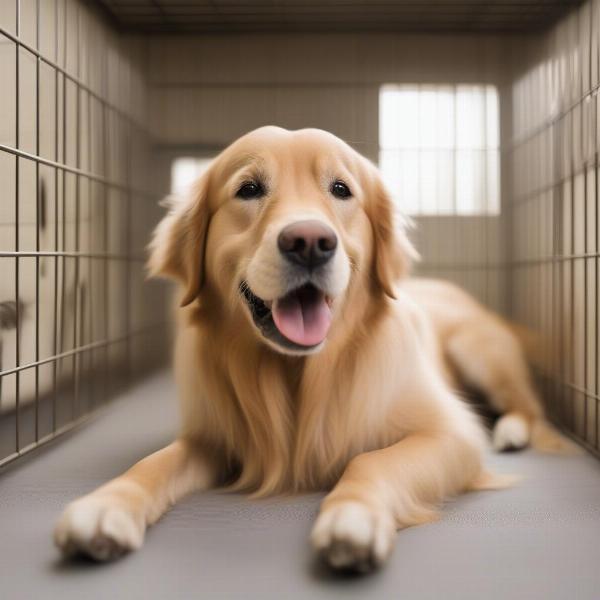Running dog kennels, also known as dog runs, offer a safe and contained space for your canine companion to exercise and enjoy the outdoors. Whether you’re looking for a temporary solution while you’re away or a permanent fixture in your backyard, understanding the different types of running dog kennels and their features is essential for making the right choice for your furry friend. This guide explores everything you need to know about selecting, setting up, and maintaining a running dog kennel.
Choosing the Right Running Dog Kennel
The ideal running dog kennel depends on several factors, including your dog’s size, breed, energy level, and the available space in your yard. Consider the following options:
-
Chain-link Kennels: These are a popular and affordable choice, offering good visibility and ventilation. Ensure the chain link is sturdy and galvanized to withstand rust and weather.
-
Metal Panel Kennels: These provide more privacy and protection from the elements. They are generally more durable than chain-link kennels but can be less visually appealing.
-
Wooden Kennels: Aesthetically pleasing, wooden kennels offer a natural look and can blend seamlessly into your backyard landscape. However, they require more maintenance to prevent rotting and damage.
-
Portable Kennels: Ideal for travel or temporary containment, portable kennels are lightweight and easy to assemble. They are typically made of fabric or mesh and are less durable than permanent structures.
Size and Location Matter
Choosing the right size kennel is crucial for your dog’s comfort and well-being. A kennel that’s too small will restrict movement and can lead to frustration and behavioral issues, while one that’s too large can be less secure. As a general rule, your dog should be able to comfortably stand, turn around, and lie down in their kennel.  Happy dog in a spacious kennel
Happy dog in a spacious kennel
The location of your running dog kennel is equally important. Select a level area with good drainage to prevent waterlogging. Consider providing shade to protect your dog from the sun, especially during hotter months.
Flooring and Enrichment
The flooring of your running dog kennel should be comfortable and easy to clean. Options include gravel, concrete, grass, or artificial turf. Avoid using materials like wood chips or mulch, which can harbor parasites and be ingested by your dog.
Enrichment is essential to prevent boredom and promote your dog’s physical and mental health. Provide toys, chew bones, and interactive puzzles to keep your dog entertained and engaged.
“A stimulating environment is key to a happy and healthy dog,” says Dr. Emily Carter, DVM. “Providing enrichment in their kennel can help prevent destructive behaviors and promote a positive experience.”
Maintenance and Safety
Regular maintenance is essential to ensure the longevity and safety of your running dog kennel. Inspect the kennel regularly for any damage or wear and tear. Clean the kennel regularly to prevent the build-up of bacteria and odors.
“Regular cleaning not only maintains hygiene but also helps identify potential hazards early on,” adds Dr. Carter. “A clean kennel is a safe kennel.”
Considering Your Dog’s Needs
Every dog is unique, and their individual needs should be considered when choosing a running dog kennel. For example, a high-energy breed like a Border Collie will require more space and enrichment than a less active breed like a Cavalier King Charles Spaniel.
Conclusion
Choosing the right running dog kennel is an investment in your dog’s well-being. By considering your dog’s specific needs and following the guidelines outlined in this guide, you can create a safe, comfortable, and enriching outdoor space for your furry companion to enjoy.
FAQ
- How often should I clean my dog’s kennel? Clean your dog’s kennel at least once a week, or more frequently if needed.
- What is the best flooring for a running dog kennel? Concrete, gravel, or artificial turf are good options for kennel flooring.
- Can I leave my dog in a running dog kennel all day? No, a running dog kennel should not be used as a substitute for regular exercise and interaction with your dog.
- What size kennel should I get for my dog? Choose a kennel size that allows your dog to comfortably stand, turn around, and lie down.
- How can I prevent my dog from escaping the kennel? Ensure the kennel is securely fenced and the gate is properly latched.
- What type of kennel is best for a small dog? A smaller chain-link or portable kennel is often suitable for small dogs.
- How can I make my dog’s kennel more enriching? Provide toys, chew bones, and interactive puzzles.
Related Articles on ILM Dog
About ILM Dog
ILM Dog is your trusted international resource for expert dog care and advice. We offer comprehensive information on breed selection, health care, training, nutrition, grooming, and much more. Whether you’re a new dog owner or a seasoned expert, ILM Dog provides practical, reliable information to help you give your canine companion the best possible care. Contact us at [email protected] or +44 20-3965-8624 for personalized guidance and support.